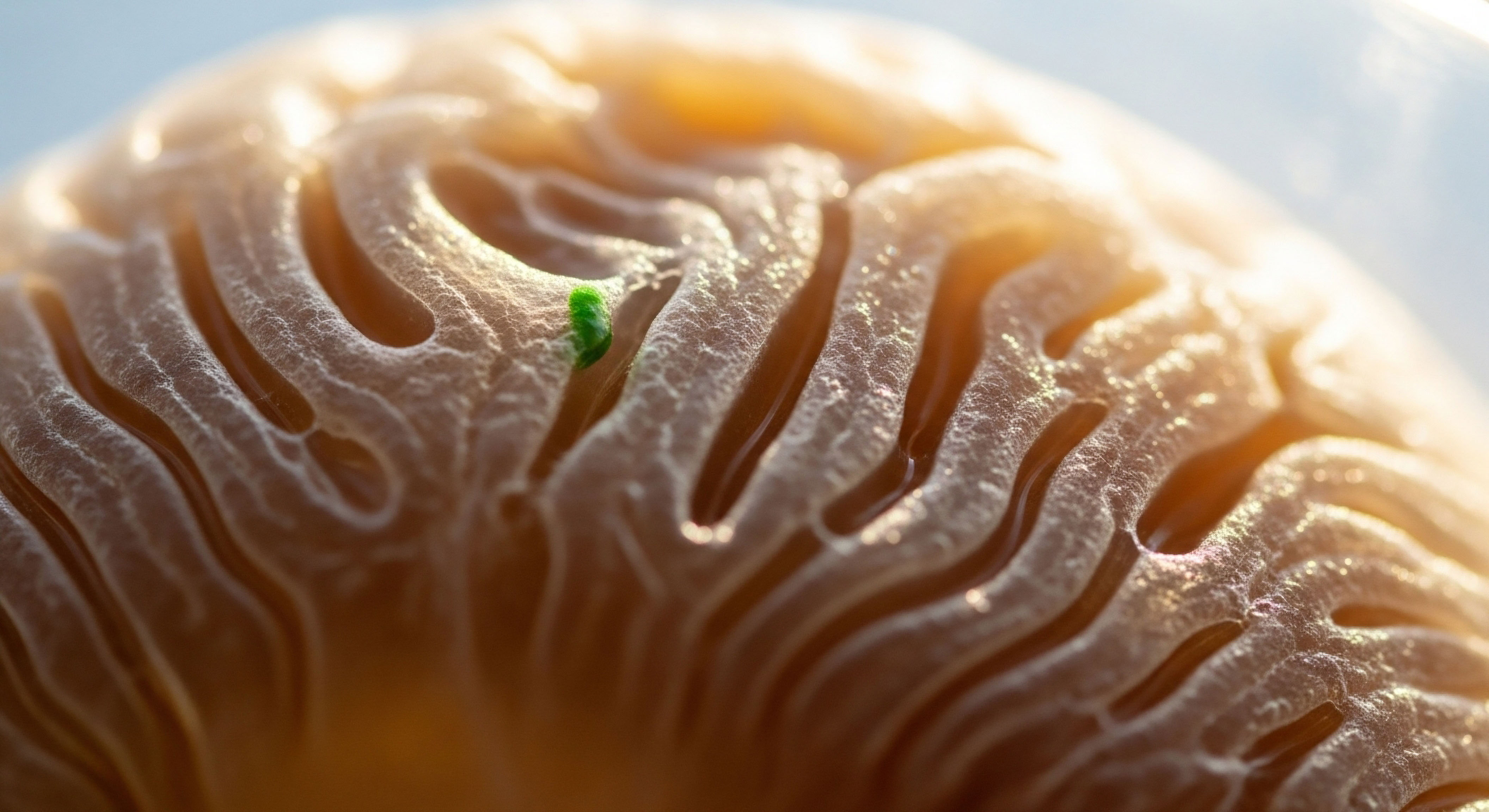

Fundamentals
The profound sense of exhaustion, the flat, colorless quality of your days, and the persistent internal fog that clouds your thoughts are valid biological signals. Your experience is the starting point of a meaningful investigation into your own internal environment.
When we consider the question of whether optimizing testosterone can alter the need for antidepressant medications, we begin by acknowledging the deep connection between our hormonal architecture and our mental and emotional states. The body does not operate in silos. Your sense of well-being is a direct reflection of an intricate, interconnected network of systems, and the endocrine system, which governs your hormones, is a primary conductor of this orchestra.
Testosterone is frequently understood in the context of male sexual function, muscle mass, and libido. This view, while accurate, is incomplete. Testosterone functions as a potent neurosteroid, meaning it is synthesized and active within the brain itself, profoundly influencing the structure and function of neural circuits.
It acts upon key brain regions responsible for emotional regulation, such as the prefrontal cortex and the amygdala. These areas are central to how we process threats, manage social-emotional responses, and maintain a stable mood.
A deficiency in this critical hormone can, therefore, manifest as symptoms that are nearly indistinguishable from those of classical depression ∞ persistent low mood, anhedonia (the inability to feel pleasure), irritability, and a stark decline in motivation and cognitive function. This overlap is not a coincidence; it is a direct consequence of shared biological pathways.
Understanding testosterone as a key regulator of brain function provides a new perspective on the origins of depressive symptoms.

The Architecture of Mood and Motivation
Our internal state is governed by a delicate balance of chemical messengers. The endocrine and nervous systems are in constant communication, a dynamic conversation that dictates how we feel, think, and act. Hormones like testosterone are foundational to this dialogue. They set the stage, influencing the production and sensitivity of neurotransmitters ∞ the brain’s more immediate chemical messengers.
When testosterone levels are suboptimal, the entire communication network can be compromised. This is why addressing the hormonal foundation is a logical and necessary step in understanding and potentially resolving symptoms of low mood.
The feeling of being “stuck” or perpetually running on empty that so many people with low mood describe has a physiological correlate. It can be traced to disruptions in the Hypothalamic-Pituitary-Gonadal (HPG) axis, the command-and-control system for testosterone production. This axis is a sensitive feedback loop.
The hypothalamus releases Gonadotropin-Releasing Hormone (GnRH), which signals the pituitary gland to release Luteinizing Hormone (LH) and Follicle-Stimulating Hormone (FSH). LH, in turn, travels to the testes in men or the ovaries in women, stimulating the production of testosterone. When this axis is dysregulated due to age, stress, or other health conditions, the resulting hormonal deficit sends ripple effects throughout the body, with the brain being one of the most affected organs.

Symptoms as Systemic Signals
The symptoms associated with low testosterone and depression are deeply intertwined because they stem from a similar root of systemic dysregulation. A comprehensive understanding requires viewing these symptoms not as isolated problems, but as indicators of an underlying imbalance. The following table illustrates the significant overlap between the clinical presentations of male hypogonadism and major depressive disorder, highlighting why one can so easily be mistaken for the other.
| Symptom | Associated with Male Hypogonadism | Associated with Major Depressive Disorder |
|---|---|---|
| Persistent Low Mood / Dysphoria | Yes | Yes |
| Fatigue and Low Energy | Yes | Yes |
| Decreased Libido | Yes | Yes |
| Irritability | Yes | Yes |
| Difficulty with Concentration | Yes | Yes |
| Sleep Disturbances (Insomnia/Hypersomnia) | Yes | Yes |
| Loss of Motivation / Apathy | Yes | Yes |
| Decreased Muscle Mass and Strength | Yes | No |
This symptomatic convergence underscores the necessity of a thorough biochemical evaluation when depressive symptoms are present. An adult experiencing a decline in mood and vitality deserves an investigation that includes a comprehensive look at their endocrine status. To treat the mood without understanding the hormonal context is to address a symptom while potentially overlooking a foundational cause. The goal of personalized wellness is to move beyond surface-level symptom management and toward the recalibration of the body’s core operating systems.


Intermediate
To appreciate how optimizing testosterone can impact mood, we must examine the specific mechanisms through which this hormone interacts with the brain’s neurochemistry. Testosterone’s influence extends far beyond simple activation; it modulates the very systems that antidepressant medications target, namely the dopamine and serotonin pathways. This creates a biological rationale for considering hormonal optimization as a primary intervention for individuals with concurrent hypogonadism and depressive symptoms.
Testosterone appears to exert a powerful influence on the dopaminergic system. Dopamine is the neurotransmitter of motivation, reward, and goal-directed behavior. Low dopamine activity is clinically associated with anhedonia, apathy, and low motivation, all hallmarks of depression. Research indicates that testosterone can increase dopamine release and enhance the sensitivity of dopamine receptors in key brain regions.
By supporting this pathway, testosterone may help restore the capacity for drive, focus, and the experience of pleasure. This provides a direct biochemical link between healthy testosterone levels and a resilient, motivated state of mind.
Testosterone directly modulates the synthesis and reception of key neurotransmitters like dopamine, which are central to mood and motivation.

Recalibrating the System a Look at Clinical Protocols
When laboratory testing confirms a diagnosis of hypogonadism in an individual presenting with depressive symptoms, a carefully managed protocol of hormonal optimization may be initiated. The objective is to restore testosterone to a healthy physiological range, thereby addressing the root biochemical deficiency. These protocols are highly personalized and medically supervised, designed to re-establish systemic balance.
A standard protocol for male hormone optimization involves several components working in synergy:
- Testosterone Cypionate This is a bioidentical form of testosterone delivered via intramuscular or subcutaneous injection, typically on a weekly basis. The goal is to provide a stable level of testosterone in the body, avoiding the peaks and troughs that can come with other delivery methods. The dose is adjusted based on follow-up lab work and clinical response.
- Gonadorelin This peptide is a GnRH analogue. Its inclusion in the protocol serves a specific and important purpose. By mimicking the body’s natural GnRH signal, it stimulates the pituitary to continue producing LH and FSH. This helps maintain the function of the testes and preserves natural testosterone production and fertility, preventing the testicular atrophy that can occur with testosterone monotherapy.
- Anastrozole Testosterone can be converted into estrogen via an enzyme called aromatase. While some estrogen is necessary for male health, excessive levels can lead to side effects like water retention, gynecomastia (breast tissue development), and mood swings. Anastrozole is an aromatase inhibitor that modulates this conversion, ensuring a healthy balance between testosterone and estrogen. Dosing is precise and based on regular monitoring of estradiol levels.

Hormonal Optimization in Women
While often considered a male hormone, testosterone is also vital for female health, contributing to libido, energy, bone density, and mood. Women, particularly during the perimenopausal and postmenopausal transitions, can experience a significant decline in testosterone levels, which can contribute to mood disorders and a diminished sense of well-being. Clinical protocols for women utilize much lower doses of testosterone, often combined with progesterone to ensure endometrial safety.
- Testosterone Cypionate For women, micro-dosing via subcutaneous injection (e.g. 10-20 units weekly) can restore physiological levels, often leading to improvements in mood, energy, and libido.
- Progesterone This hormone has calming, anti-anxiety effects and is prescribed based on a woman’s menopausal status to balance the effects of other hormones and support overall well-being.
- Pellet Therapy Another option involves the subcutaneous implantation of small, long-acting pellets of testosterone, which provide a steady release of the hormone over several months.

The Role of Neurotrophic Factors BDNF
Beyond its direct impact on neurotransmitters, testosterone plays a foundational role in maintaining the physical health and plasticity of the brain. It does this, in part, by regulating the expression of Brain-Derived Neurotrophic Factor (BDNF). BDNF is a protein that acts like a fertilizer for brain cells.
It supports the survival of existing neurons, encourages the growth of new neurons (neurogenesis), and promotes the formation of new connections (synapses). Low levels of BDNF are consistently found in individuals with major depression, and many antidepressant medications are thought to work, in part, by increasing BDNF levels over time.
Research has shown that testosterone can increase BDNF levels in key brain areas. This suggests that restoring testosterone may directly combat the neural atrophy associated with chronic stress and depression. By promoting a healthier, more adaptable brain environment, hormonal optimization may enhance cognitive function, improve emotional resilience, and reduce the biological substrate of depressive illness.
This mechanism provides a powerful explanation for how correcting a hormonal deficiency can lead to sustained improvements in mental health, potentially reducing the reliance on other psychiatric medications.


Academic
A sophisticated analysis of the interplay between testosterone and depressive psychopathology requires a systems-biology perspective, moving beyond linear cause-and-effect models to appreciate the complex, bidirectional relationships between the endocrine, nervous, and immune systems. The central thesis is that hypogonadism represents a state of compromised neurobiological homeostasis, which in turn lowers the threshold for developing depressive syndromes. Optimizing testosterone levels, from this viewpoint, is an intervention aimed at restoring systemic resilience rather than merely treating a symptom.
The Hypothalamic-Pituitary-Gonadal (HPG) axis does not operate in isolation. It is intricately linked with the Hypothalamic-Pituitary-Adrenal (HPA) axis, the body’s primary stress-response system. Chronic stress leads to elevated cortisol levels, which can suppress the HPG axis, leading to lower testosterone production.
Conversely, low testosterone levels can impair the negative feedback regulation of the HPA axis, leading to a state of heightened stress reactivity. This creates a vicious cycle where low testosterone and high stress perpetuate each other, fostering a biochemical environment conducive to depression. Studies have shown that men with hypogonadism have an increased incidence of depressive illnesses, with some research indicating a hazard ratio as high as 4.2 after adjusting for covariates.

What Is the Neuroinflammatory Hypothesis?
Recent research has implicated chronic, low-grade neuroinflammation as a key pathophysiological mechanism in major depressive disorder. Pro-inflammatory cytokines can alter neurotransmitter metabolism, reduce BDNF expression, and induce depressive-like behaviors. Testosterone exerts significant immunomodulatory effects, generally promoting an anti-inflammatory state.
Androgens can suppress the production of certain pro-inflammatory cytokines while promoting anti-inflammatory mediators. Therefore, a hypogonadal state can be conceptualized as a pro-inflammatory condition within the central nervous system. By restoring physiological androgen levels, Testosterone Replacement Therapy (TRT) may help quell this underlying neuroinflammation, thereby addressing a core driver of the depressive process. This provides a mechanistic link that connects a peripheral endocrine deficiency to a central nervous system pathology.

The Impact on Neurogenesis and Neural Plasticity
The adult brain retains the ability to generate new neurons, particularly in the dentate gyrus of the hippocampus, a region critical for memory and mood regulation. This process, known as adult neurogenesis, is impaired by chronic stress and is consistently reduced in animal models of depression.
The efficacy of many conventional antidepressants is correlated with their ability to stimulate hippocampal neurogenesis. Testosterone and its metabolites have been shown to be potent promoters of neuron survival and plasticity. The hormone appears to selectively enhance the survival of newly generated neurons.
This action may be mediated through both direct androgen receptor signaling on new neurons and indirect routes involving the upregulation of BDNF. Therefore, the therapeutic effect of testosterone optimization may stem from its ability to repair and rejuvenate the very neural circuits that are damaged by stress and depression, offering a restorative potential that goes beyond simple neurotransmitter modulation.
The following table outlines the comparative mechanisms of action, highlighting the distinct yet overlapping pathways through which these interventions may alleviate depressive symptoms.
| Mechanism | Selective Serotonin Reuptake Inhibitors (SSRIs) | Testosterone Replacement Therapy (TRT) |
|---|---|---|
| Primary Target | Serotonin transporter protein (SERT) | Androgen receptors (AR) throughout the body and brain |
| Neurotransmitter Effects | Acutely increases synaptic serotonin; downstream effects on other neurotransmitters | Modulates dopamine synthesis and receptor sensitivity; indirect effects on serotonin. |
| Neurotrophic Effects | Gradually increases BDNF expression over weeks to months | Directly increases BDNF expression and enhances neuronal survival. |
| Inflammatory Effects | Some secondary anti-inflammatory effects | Directly suppresses pro-inflammatory cytokines |
| HPA Axis Regulation | Can help normalize HPA axis function over time | Directly involved in the negative feedback regulation of the HPA axis |

How Does Androgen Receptor Signaling Affect Gene Transcription?
The ultimate effects of testosterone are mediated at the genomic level. After binding to its receptor in the cytoplasm, the testosterone-receptor complex translocates to the cell nucleus, where it binds to specific DNA sequences known as Androgen Response Elements (AREs).
This binding event initiates the transcription of a vast array of genes, including those involved in neurotransmitter synthesis, receptor expression, synaptic plasticity, and cell survival. For example, testosterone can modulate the gene expression of tyrosine hydroxylase, the rate-limiting enzyme in dopamine production, and the dopamine transporter (DAT).
This genomic action explains why the effects of hormonal optimization are profound and systemic. It is a fundamental recalibration of cellular machinery in the brain and throughout the body. The decision to initiate such therapy in a patient with comorbid hypogonadism and depression is based on the understanding that one is treating a foundational regulatory system.
The potential to reduce or eliminate the need for antidepressant medication stems from this ability to address the underlying biology of resilience and well-being at a genetic level, restoring the brain’s capacity to regulate itself effectively.

References
- Indirli, R. Lanzi, R. Arosio, M. Mantovani, G. & Ferrante, E. (2023). The association of hypogonadism with depression and its treatments. Frontiers in Endocrinology, 14.
- Seidman, S. N. & Rabkin, J. G. (2001). Testosterone Replacement Therapy for Hypogonadal Men With Major Depressive Disorder ∞ A Randomized, Placebo-Controlled Clinical Trial. The Journal of Clinical Psychiatry, 62 (6), 407 ∞ 412.
- Shores, M. M. et al. (2004). Depression in Men with Age-Associated Hypogonadism. American Family Physician, 70 (9), 1765-1766.
- Hormone Health Network. (2020). Testosterone and Androgens. Endocrine Society.
- Reddy, D. S. (2010). Neurosteroids ∞ Endogenous role in the human brain and therapeutic potentials. Progress in Brain Research, 186, 113-137.
- McHenry, J. et al. (2014). On the effects of testosterone on brain behavioral functions. Hormones and Behavior, 66 (5), 719-725.
- Rasmusson, A. M. et al. (1999). BDNF mediates the effects of testosterone on the survival of new neurons in an adult brain. Neuron, 22 (1), 53-62.
- Spritzer, M. D. & Galea, L. A. M. (2013). Testosterone and Adult Neurogenesis. Vitamins and Hormones, 93, 261-305.
- Purves-Tyson, T. D. et al. (2014). Testosterone induces molecular changes in dopamine signaling pathway molecules in the adolescent male rat nigrostriatal pathway. PLoS One, 9 (3), e91151.
- de Ronde, W. & de Jong, F. H. (2011). Aromatase inhibitors in men ∞ effects and therapeutic options. Reproductive Biology and Endocrinology, 9, 93.

Reflection
The information presented here serves as a map, illustrating the profound biological connections between your hormonal health and your emotional well-being. It is designed to transform complex clinical science into empowering knowledge, shifting the perspective from one of passive suffering to one of active, informed investigation.
Your personal experience of your symptoms is the most important piece of data in this entire process. It is the starting point for a conversation with a qualified healthcare provider who can help you interpret your body’s signals through the lens of objective laboratory data.

What Is Your Body Communicating to You?
Consider the symptoms you have been experiencing not as personal failings but as a form of communication from your body. The fatigue, the low mood, the lack of motivation ∞ these are all pieces of a larger puzzle. Understanding the science behind these feelings is the first step toward assembling that puzzle and seeing the complete picture of your health.
This journey is about biological restoration. It is about providing your body with the foundational materials it needs to function optimally, allowing your mind to follow suit. The path forward involves a partnership between your lived experience and a rigorous, evidence-based clinical approach. This knowledge is your tool to begin that dialogue and reclaim a state of vitality that is your birthright.



